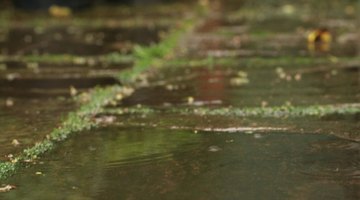Herbicides That Can Be Used Near Water
Herbicides are chemicals that are used to control of unwanted plants like weeds. Herbicides are also required in water to control the growth of emergent, submerged or floating weeds. Not all herbicides are safe for use near water as they can harm aquatic life. The herbicides that are approved for use in and around water are only those approved by the U.S. Environmental Protection Agency. These herbicides include 2,4-D, glyphosate and fluridone.
Glyphosate

Glyphosate is a systemic herbicide which is commonly used to control the growth of floating plants like water lilies and shoreline plants such as purple loosestrife. The herbicide is generally applied to the leaves of the plant in liquid form. The herbicide is not effective on submerged plants like Eurasian watermilfoil. Some tradenames for the aquatic herbicides containing glyphosate include AquaMaster, AquaPro and Rodeo. It can take a few weeks for the plants to die after the application of glyphosate. Repeat applications are often required to cover the plants that were initially missed.
Fluridone
Fluridone is a systemic slow-acting herbicide used for the control of underwater plants like Eurasian watermilfoil. The herbicide is used both as a pellet and liquid. The herbicide is most effective in slow moving waters. Fluridone is not effective as a spot treatment in areas smaller than 5 acres. It can take between 6 to 12 weeks for plants to die after application. The trade names for fluridone include Whitecap and Sonar. If used in very low concentration fluridone is not highly effective on certain native aquatic plants such as pondweeds.
2,4-D
2,4-D is a fast acting, selective and systemic herbicide that is most effective on a number of broad-leaf weeds and Eurasian watermilfoil. AquaKleen and Navigate are the two formulas of 2,4-D which are exclusively for aquatic use. Both herbicides are available in liquid and granular form and are effective for spot treating Eurasian watermilfoil. 2,4-D is not allowed to be used in waters that contain threatened and endangered species of salmon. These waters are mostly in the Pacific Northwest.
References
Writer Bio
Irum Sarfaraz is a freelance writer with over 20 years of nonfiction writing experience in newspaper op-eds and magazine writing, book editing, translating and research writing. Sarfaraz is originally from Pakistan and has been published in both American and Pakistani newspapers and magazines. She holds a Bachelor of Arts in English literature, and diplomas in nonfiction writing.
Photo Credits
- rain image by hazel proudlove from Fotolia.com
More Articles



